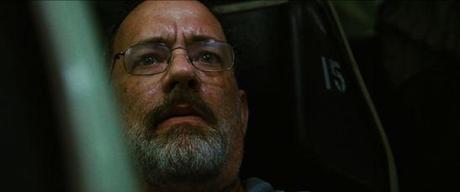- By Ben L.

In a recreation of the 2009 hostage taking of Richard Phillips, captain of the container ship MV Maersk Alabama off the Somali coast, Tom Hanks spends most of the time looking down the barrel of a gun.
Captain Phillips keeps audiences feeling the same way too throughout its 134-minute run, thanks to the visceral filmmaking style of Paul Greengrass honed in the second and third Bourne films.
The director is also no stranger to adapting stories of survival and acts of heroism for the big screen, having thrown audiences in the hijacking of the ill-fated 9/11 flight in 2006’s critically acclaimed United 93. Captain Phillips delivers more of the same gripping drama, this time with stellar performances from an Academy Award winner and a Hollywood debutant.
Phillips is an average American family man tasked with the dangerous job of transporting cargo aboard his container ship, the MV Maersk Alabama, through pirate-infested waters near Somalia. Apprehensive about his shipping job, especially after receiving several emails about an increase in pirate attacks in the area, Phillips’s worst fears are confirmed when he spots two boats carrying armed men headed for his ship.
It seems Phillips’s evasive manoeuvres could actually work. But the boats manage to catch up with his ship, a ladder is deployed, and soon the captain is staring into the eyes of his captors on the ship’s bridge.
Hanks delivers an excellent performance, taking audiences on a roller-coaster ride of his character’s emotions. From initial skepticism that the pirates would actually succeed in getting their ransom, to confidence and jubilance that he would definitely be rescued, and then resignation that he might actually be killed, Hanks gives audiences a believable portrayal of a hostage’s mental state.

Contrasting the Hollywood veteran in superb fashion is Barkhad Abdi, who makes his first movie appearance as Abduwali Muse, a young skinny Somali fisherman in charge of the pirate operation. In a battle of two captains, Abdi does not allow Hanks to overshadow him on-screen, instead proving to be a formidable adversary in the first half of the film with his eerily intense stares and determination to succeed in getting his money.
Their first confrontation, where Muse tells Phillips, “Look me in the eye – I’m the captain now!” already sets the tense mood of the American’s ordeal. It develops into a highly tense game of cat-and-mouse as Phillips constantly tries to look for an opportunity to escape. But each time he gets caught doing something fishy, the pirates lose even more patience. Muse’s several warnings to him – “No games,” he tells the American eager to break free – heightens the battle of wits, as one wrong move could mean blood spilled.
Muse’s banter with Phillips also provides a glimpse into the real-world circumstances of globalisation and over-fishing that have forced the Somali fishermen to partake in piracy. His plight is made to look even more ironic when it is revealed that the ship he had hijacked was in fact carrying food aid to African nations, and Abdi’s extraordinary acting evokes the audience’s sympathy for his character who until the end of the film sincerely believed that he would receive the money he had demanded.
This is where Captain Phillips also becomes the strongest and outshines United 93. It not only portrays the human will to survive, but also uses the relationship between Phillips and Muse as a platform to highlight the clash of cultures between the privileged Western world and a Third World nation languishing in poverty.

Tight spaces and dark corridors add claustrophobia to Phillips’s already frightening ordeal – cinematographer Barry Ackroyd, who also worked on the Oscar-winning The Hurt Locker, successfully puts audiences in a trapped situation, especially in the second part of the film when the captain is held captive on a lifeboat in the middle of the ocean. Wide shots of the small orange boat floating in a vast blue emptiness, and later dwarfed by enormous Navy ships, further emphasize the desolation of the men in the lifeboat. Early in the film, Muse goes hunting for Phillips’s crew hiding in the lower decks of the Alabama, and a searching flashlight attached to a rifle and his footsteps on the stairwell are all that is needed to instill fear and tension in a cleverly executed scene.
The movie escalates into a chaotic frenzy in the standoff’s last moments when US Navy SEALs intervene to resolve the situation, and closes with the most powerful performance delivered by Tom Hanks. Aboard the US navy ship after his rescue, he breaks down in shock while being medically examined. Virtually speechless and unable to answer the routine questioning of a nonchalant medic, the juxtaposition of emotions is immensely gripping – a fitting end to a movie that does not let go of its hold on the audience the entire time.
Some events in the film may be inaccurate as it is based on Richard Phillips’s book, which has met with strong criticism for making the captain look more heroic than he actually was. But on the whole Captain Phillips is a superb retelling of a man’s ordeal in captivity, and demolishes conventional notions of the Hollywood hero.


